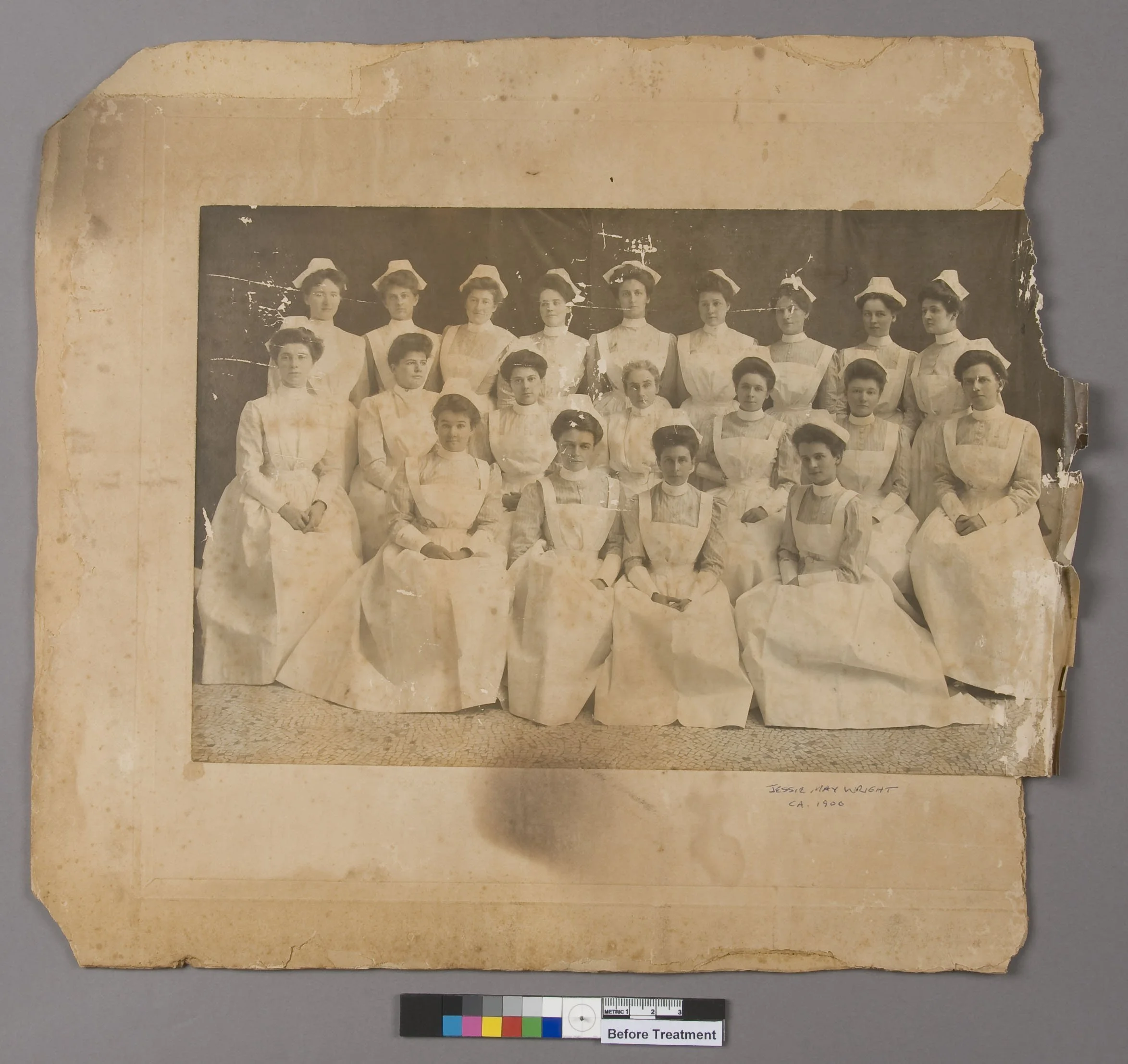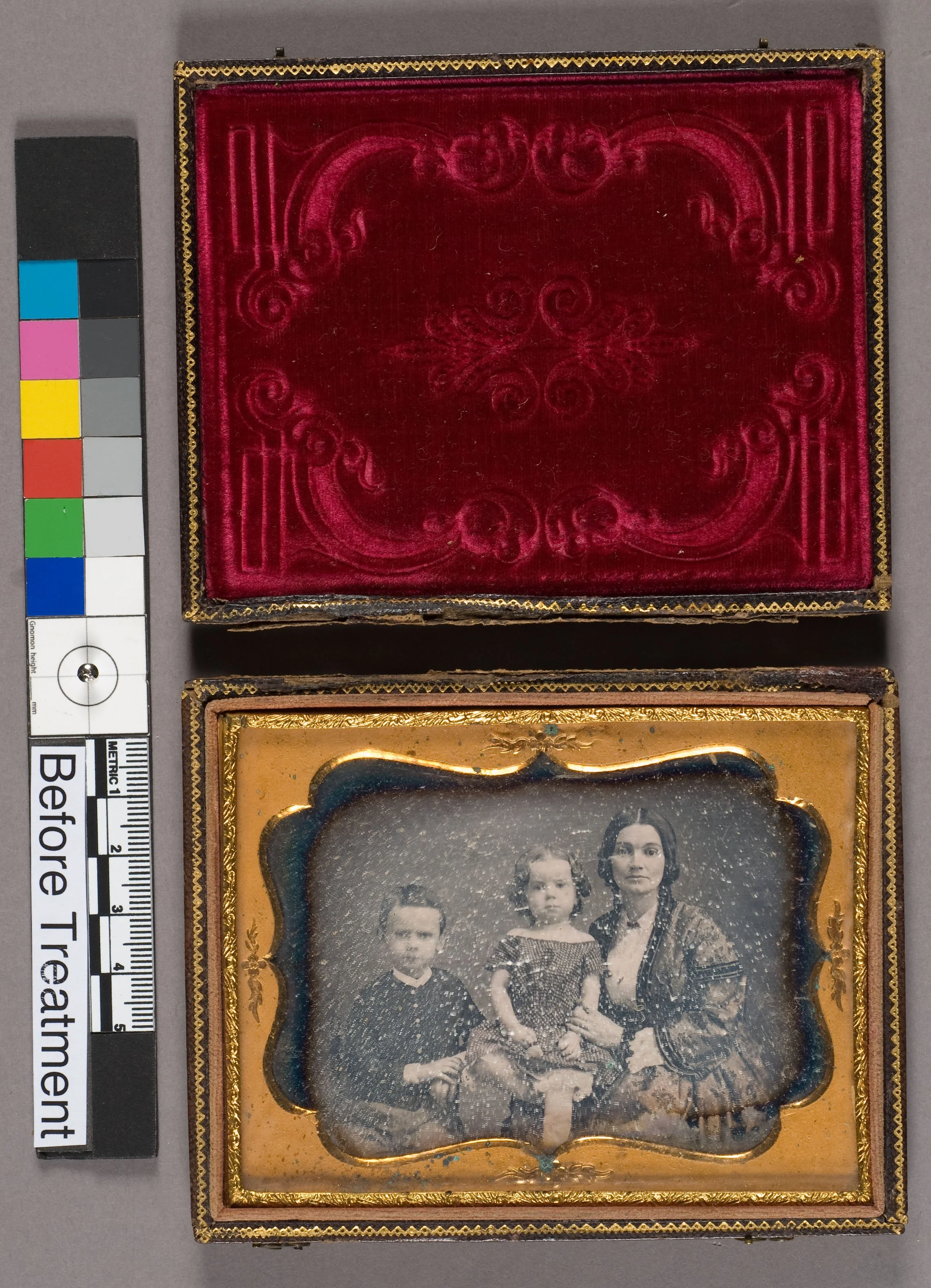
Conservation Projects
Photomechanical Prints: History, Technology, Aesthetics, and Use
For roughly 150 years, we have been accustomed to seeing photomechanical prints on a daily basis. Prints exist in a variety of milieus with multiple variations over time, use, and geography. Historic and contemporary examples are prevalent in museums, libraries, archives, and personal collections worldwide. Photomechanical prints developed to fill many needs; these include practical and economical methods for mass reproduction, techniques to facilitate the simultaneous printing of images and text, increased image permanence, a perception of increased truthfulness and objectivity, and an autonomous means of artistic expression. They exist at intersections of numerous disciplines: photography and printmaking, functional and artistic practices, the histories of photography and the graphic arts, and the specialties of paper and photograph conservation.
Photomechanical Prints: History, Technology, Aesthetics, and Use is presented by the Foundation for Advancement in Conservation (FAIC) as part of the Collaborative Workshops in Photograph Conservation series. The in-person gathering took place from October 30 - November 3, 2023 and consisted of a 3-day symposium, hosted by the National Gallery of Art in Washington, D.C., flanked by 2 days of hands-on workshops and tours of local collections. The program provided an opportunity for conservators, curators, historians, scientists, collections managers, catalogers, archivists, librarians, educators, printmakers, artists, and collectors to convene and collaborate while exploring all aspects of photomechanical printing. During the symposium, distinguished specialists provided lectures focused on contemporary and historic photomechanical print production including aspects of invention, adaptation, materiality, cultural impact, market value, artistic significance, and preservation. Hands-on workshops provided smaller groups a chance to intensify their study of identification techniques or try their hand at printing processes with the instruction of world-renowned practitioners of photogravure and collotype. Tours of prominent local collections allowed participants to see a wide range of examples of historic and contemporary prints.
Recordings of the symposium presentations are now available online!
Treatment of Crayon Enlargments
Crayon enlargements are photographic prints with hand-applied media such as pastel, chalk, watercolor, and conté crayon. The photographs are usually silver-based images projection-printed onto lightweight paper. Typically, the prints are mounted onto a secondary support either of paperboard or of canvas that is stretched across a wood strainer. Convex crayon portraits are also common and consist of rectangular or oval secondary paperboard mounts that have been molded to a convex shape. Photographic enlargements, such as the photograph component in crayon enlargements, became possible after the introduction of the solar enlarging camera in 1857. Crayon enlargements were popular in the United States from the 1860s through the 1920s. Crayon enlargements could be colorful or monochromatic black, with media applied by hand or with an airbrush. The papers used as the primary support (the photosensitized paper) were usually of good quality made with cotton and linen fibers. However, the paperboard mounts consist of poor quality wood pulp that is acidic, becomes extremely brittle and darkens over time. Excessive light exposure from decades of continuous display, along with possible high temperatures, fluctuating relative humidity, poor handling, and insect and water damage often leaves these portraits in a state of severe degradation.
Read the blog post for more infromation on conservation treatment to restore stability and beauty to these examples from the Nelson Jordan Family Collection at the Library of Congress.
WWI Panorama Photograph from the Nelson W. Jordan Family Papers
A panoramic portrait photograph of the Howard University training detachment taken on July 21, 1918, by the Scurlock Photo studio is part of the Nelson W. Jordan Family Papers held by the Manuscripts Division of the Library of Congress. The panorama was acquired framed and in very bad condition. Read this blog post for a description of its treatment.
Emily Howland Photograph Album
The Emily Howland photograph album is jointly owned by the Library of Congress and the Smithsonian National Museum of African-American History and Culture. The album is an ornate Civil war era carte-de-visite (CdV) album that was gifted to Emily Howland in 1864 while she was teaching at a freedmen’s camp and school in Virginia. Howland was a Quaker, educator, abolitionist, suffragist, philanthropist and a lifelong activist. Her album contains photographs of family, friends, and colleagues, as well as images of notable abolitionists, politicians, teachers, and celebrities of the era. Of particular interest is the CdV located on the final page of the album: a previously unrecorded portrait of Harriet Tubman.
This collaborative project included research on the history, manufacture, materials and cultural significance of the album, as well as examination, documentation, analysis, treatment, and housing of the album. Strategies for long-term preservation and exhibition were also developed. The excitement surrounding the newly discovered portrait of Harriet Tubman resulted in the album and its treatment receiving tremendous publicity and widespread interest leading to many opportunities for discussion and public outreach.
Heat- and solvent-set repair tissues
This research project was a collaboration between the Library of Congress and the National Archives and Records Administration. The aim was to identify successful preservation-quality adhesives and methods for production and use of precoated heat- and solvent-set tissues. These materials have been used by conservators for decades to mend library and archival materials. Since they can be used without introducing moisture, they are essential for mending of tracing papers, brittle newspapers, mold-damaged papers, and papers with water-sensitive media present. A variety of adhesives have been used over the years, but the research team had begun to question the quality of some of the adhesive mixtures in use.
Technical study of Paul Strand’s platinum prints
Paul Strand (1890-1976) was a preeminent Modern American photographer who masterfully employed the platinum and palladium processes to create many of his most striking photographs from the 1910s through the 1930s. This technical study focused on Strand’s platinum and palladium printing materials, techniques, and preferences, including his use of the Platinotype Co.’s Japine platinum papers, and the aesthetic concerns driving these choices. It is commonly believed that Strand used additives, toners, coatings, and other modifications to alter his photographic papers in order to achieve the exact look he desired. Deterioration of Strand’s prints, including severe cracking and staining, have been observed and was of particular interest.
The project included a review of primary documents and secondary literature regarding Strand’s working methods and materials. Select prints in the collections at the Philadelphia Museum of Art, the Museum of Fine Arts, Boston, and the Center for Creative Photography were examined. The study continued with extensive visual examination, written and photographic documentation, and scientific analysis of Strand prints in the National Gallery of Art Department of Photographs collection. XRF analysis was conducted on twenty-five photographs. Additional analysis of select prints included ATR-FTIR, FTIR, GC-MS, SEM, colorimetry, microfadeometry, multi-spectral imaging, and microscopy for fiber and sizing identification. Thirty-two photographs in the Paul Strand Photograph Collection at The Center for Creative Photography in Tucson, Arizona were also analyzed with XRF.
The knowledge gained through this technical study has provided a better understanding of Strand’s working methods and materials. This information has informed the development of improved strategies for the conservation treatment, storage, and exhibition practices that ensure the long-term preservation of Strand’s seminal work in platinum and palladium.
The Last Full Measure
From April 12 through August 13, 2011 the Library of Congress presented a major exhibition highlighting items from the Liljenquist Family Collection of Civil War Photographs. The exhibition, titled The Last Full Measure, consisted of 379 cased and framed ambrotype and tintype portraits and was meant to serve as a memorial to all the soldiers who lost their lives while fighting in the American Civil War (1861-1865). The photographs were arranged in a patchwork quilt-like manner and displayed in six floor-standing cases. This exhibition design, while unique and visibly pleasing, posed a great challenge to the Conservation Division. A stable mounting solution had to be found in order to secure approximately 63 objects laid out in nine to ten horizontal rows per display case. Research and testing was also conducted on the use of ethanol-reactivated tissues for leather hinge repair of cased objects. This project included examination, treatment, mounting, and installation of the objects in a timely manner in order for the exhibition to open on its symbolically important opening date; the 150th anniversary of the beginning of the Civil War.
Seperation of blocked negatives
A group of 343 non-accessioned black and white silver gelatin 4 x 5 inch sheet film negatives from the Henry Clay Anderson Collection of the Smithsonian National Museum of African-American History and Culture served as experimental treatment objects for this research project. The goal of the project was to systematically evaluate treatment options for separating severely water-damaged and blocked film-based negatives. A comprehensive list of 23 treatment strategies was identified and the treatments were tested and evaluated. The most promising treatment technique identified involved immersing the blocked negatives in cold de-ionized water followed by freezing. Immersing the negatives in cold de-ionized water, slightly acidic water, and in a 3:1 ethanol and de-ionized water bath were also found to be satisfactory treatment options.
Technical study of hand-painted tintypes
This technical study was conducted on three whole-plate hand-painted tintypes in order to gain a better understanding of the materials used in their manufacture. Two of the tintypes belong to the Smithsonian National Museum of American History’s Photographic History Collection and one tintype is from the Winterthur/University of Delaware Program in Art Conservation’s study collection. The selected tintypes were heavily over-painted portraits of women which share several similar painted elements including an opaque purplish background, white lace, gold jewelry, pink lips, and dark hair. This study included a literature review as well as the visual examination and scientific analysis of the chosen tintypes. Ultraviolet induced visible fluorescence, x-ray fluorescence (XRF), Fourier-transform infrared spectroscopy (FTIR), Raman spectroscopy, scanning electron microscopy with energy-dispersive spectroscopy (SEM-EDS), gas chromatography-mass spectrometry (GC-MS), cross-section microscopy, and polarized light microscopy (PLM) were used as analytical techniques. The technical analysis concentrated on the hand-painted elements with a particular focus on the background paint. An oil binder was identified as well as several pigments including lead white, calcium carbonate, vermilion, chrome yellow, umber, carbon black, and Prussian blue. Analytical results were compared with descriptions of hand-painting techniques and materials found in several 19th-century photographic manuals.





































